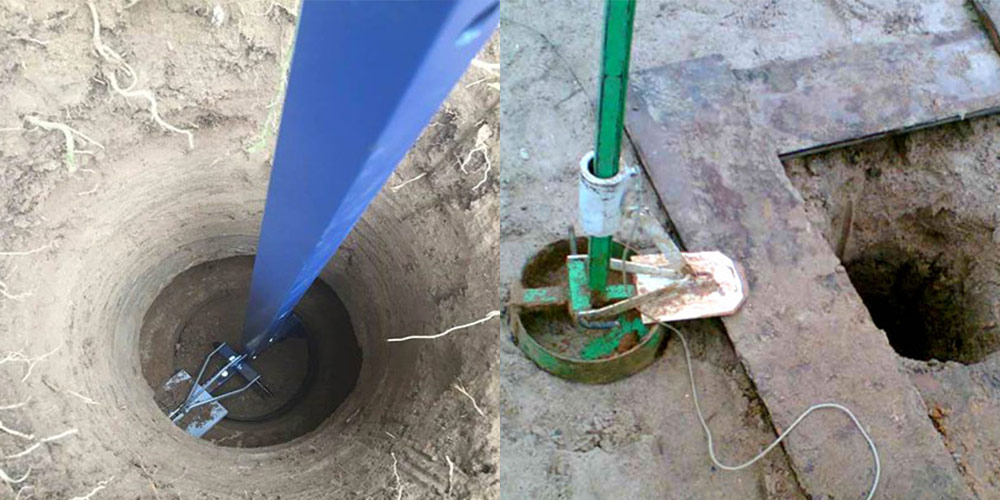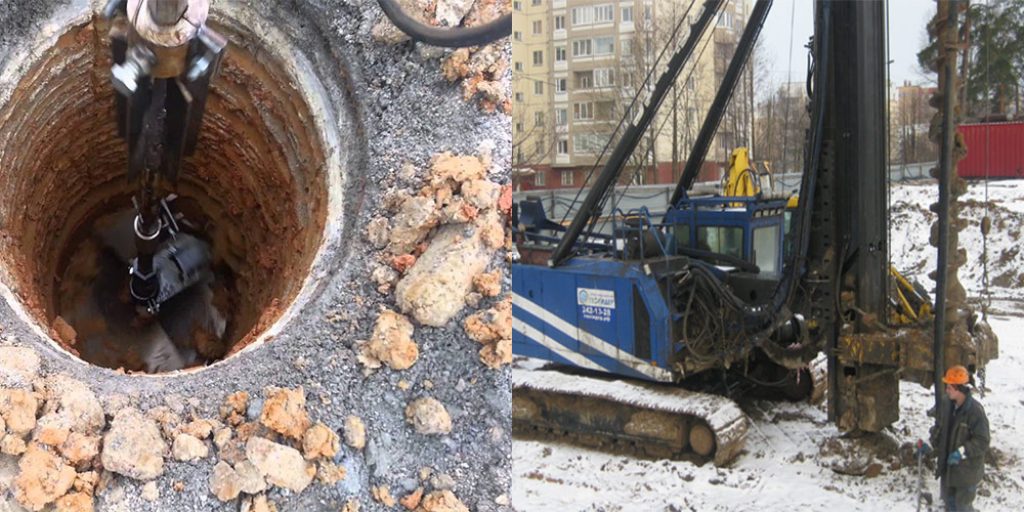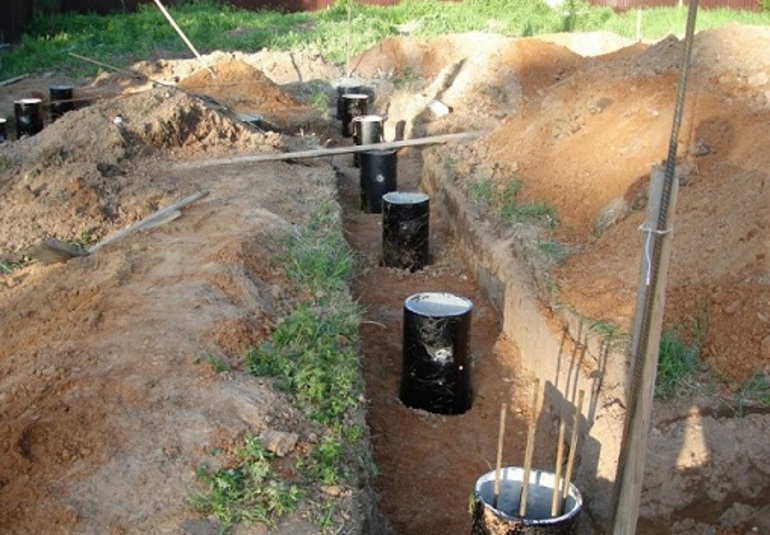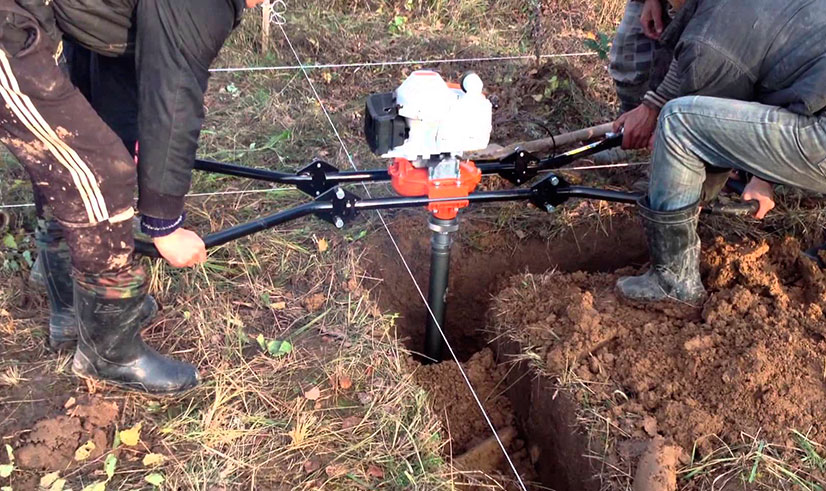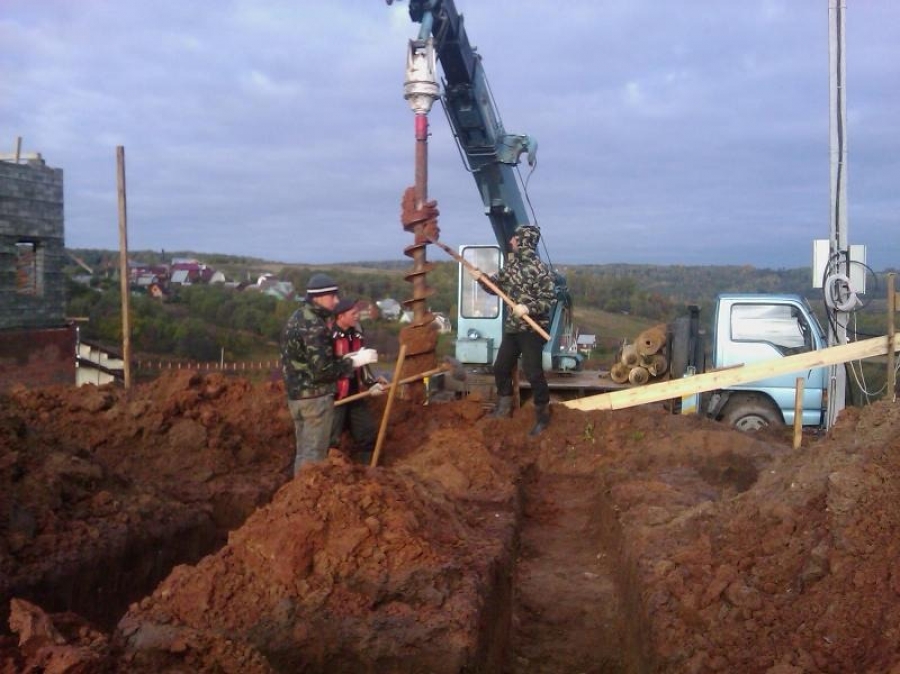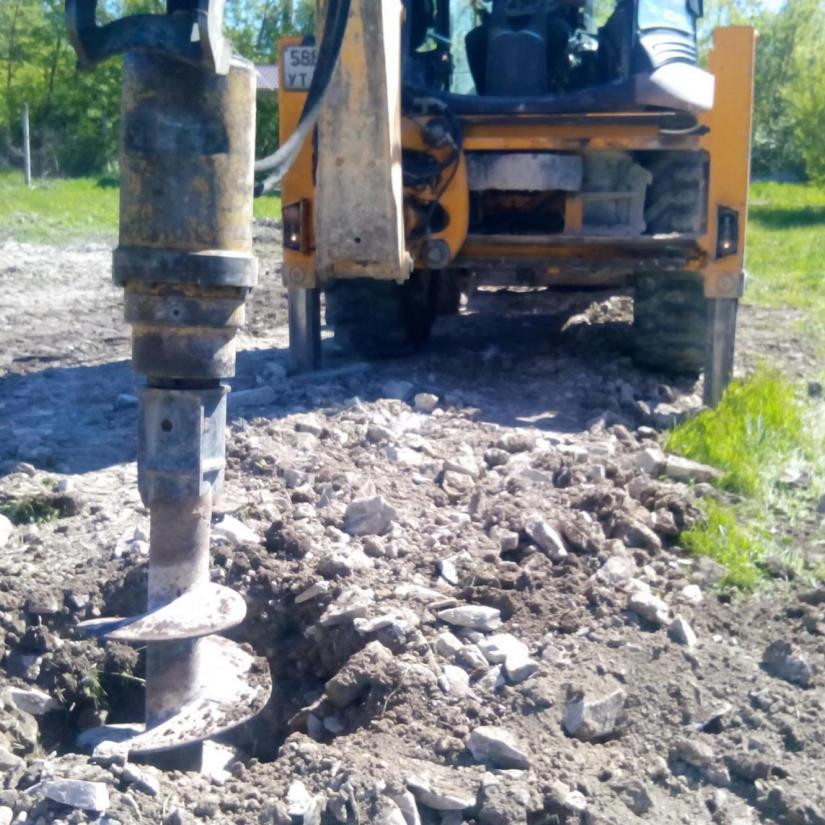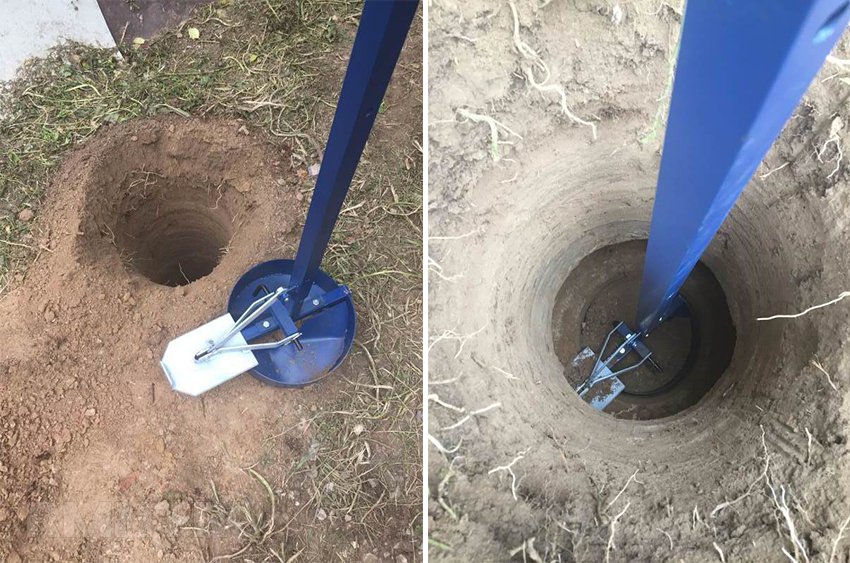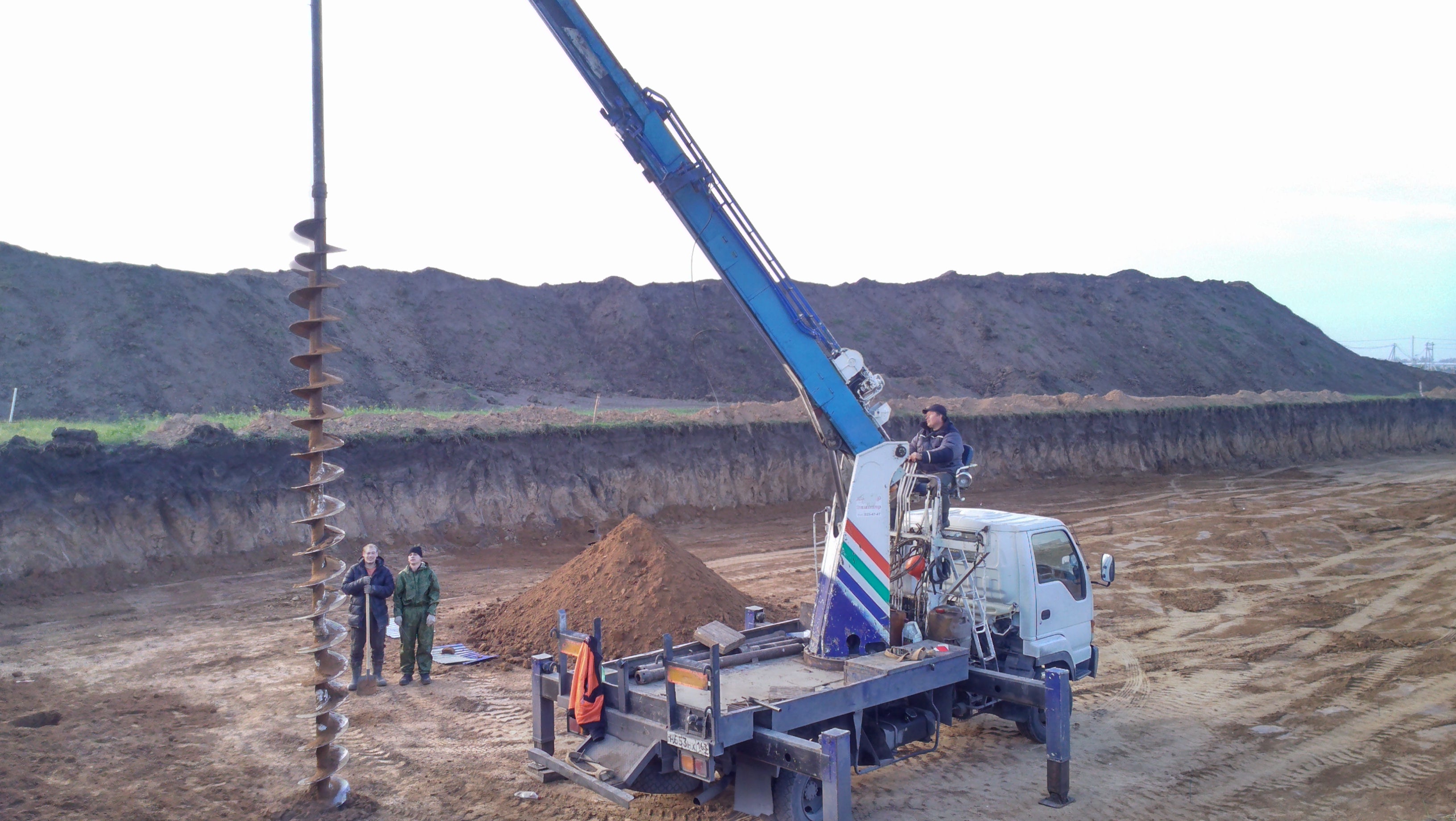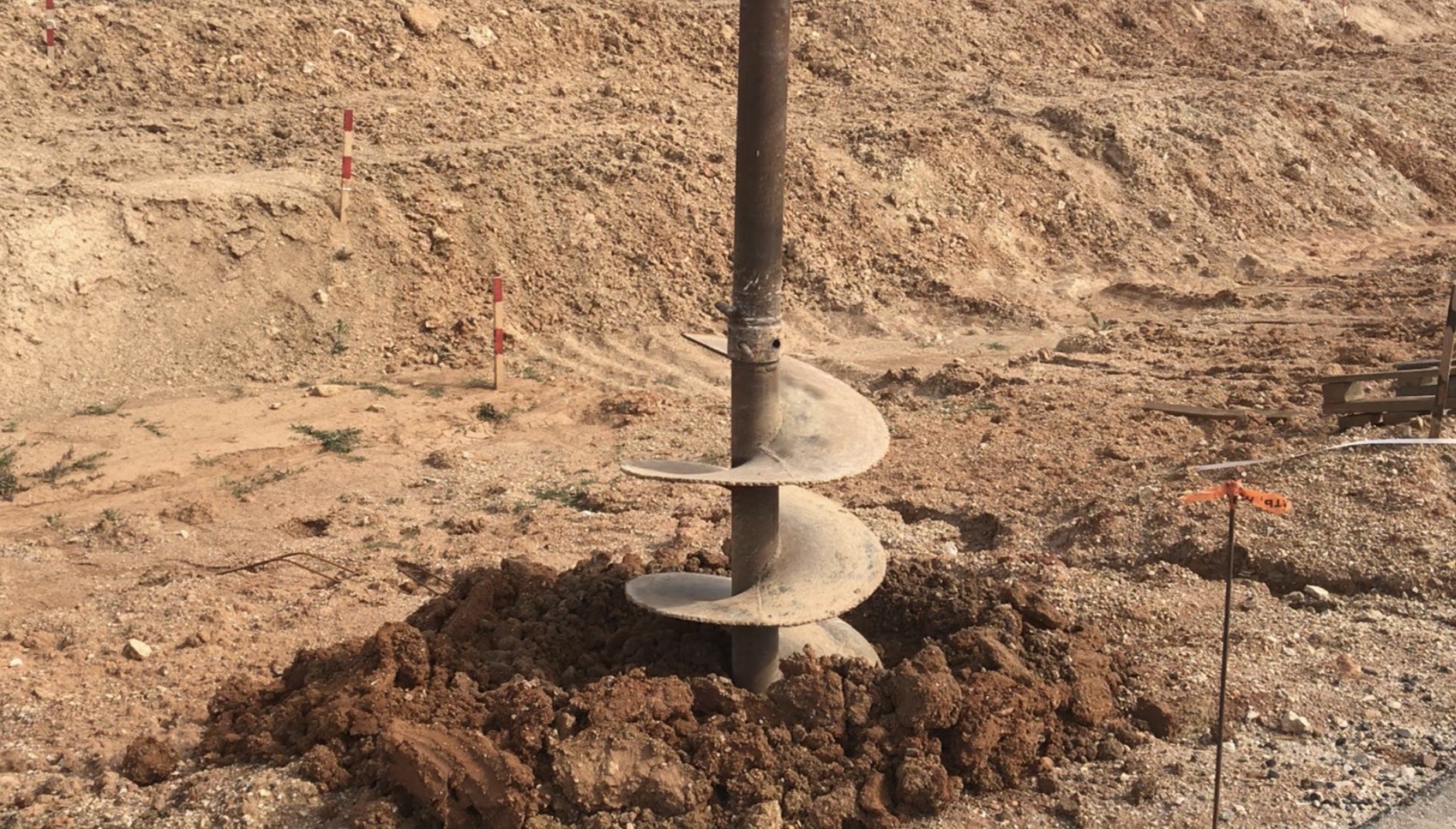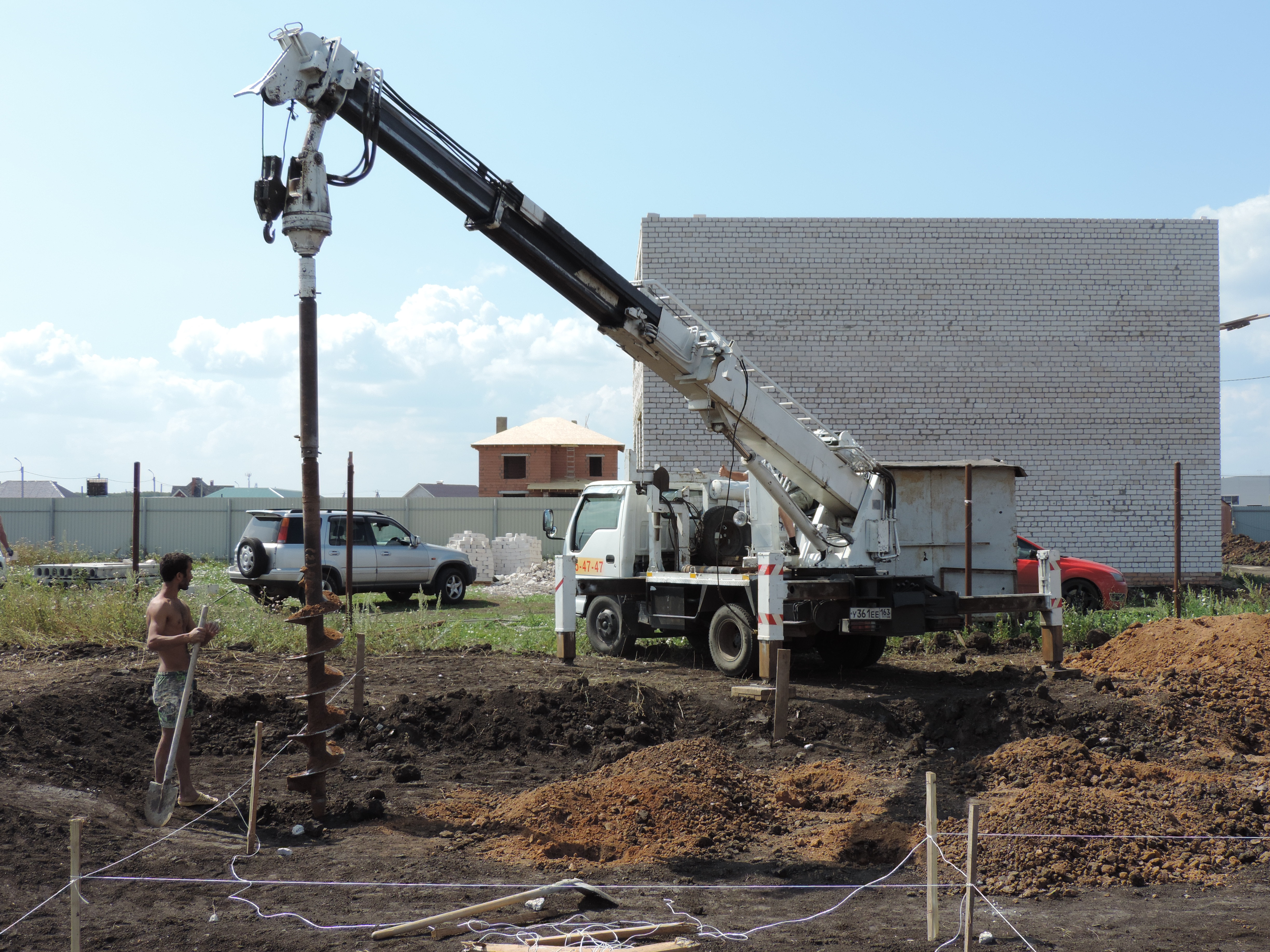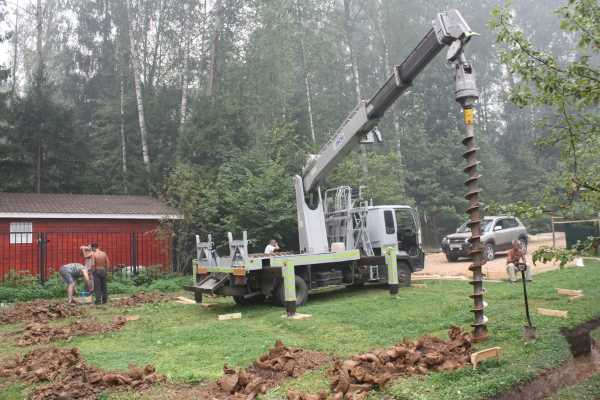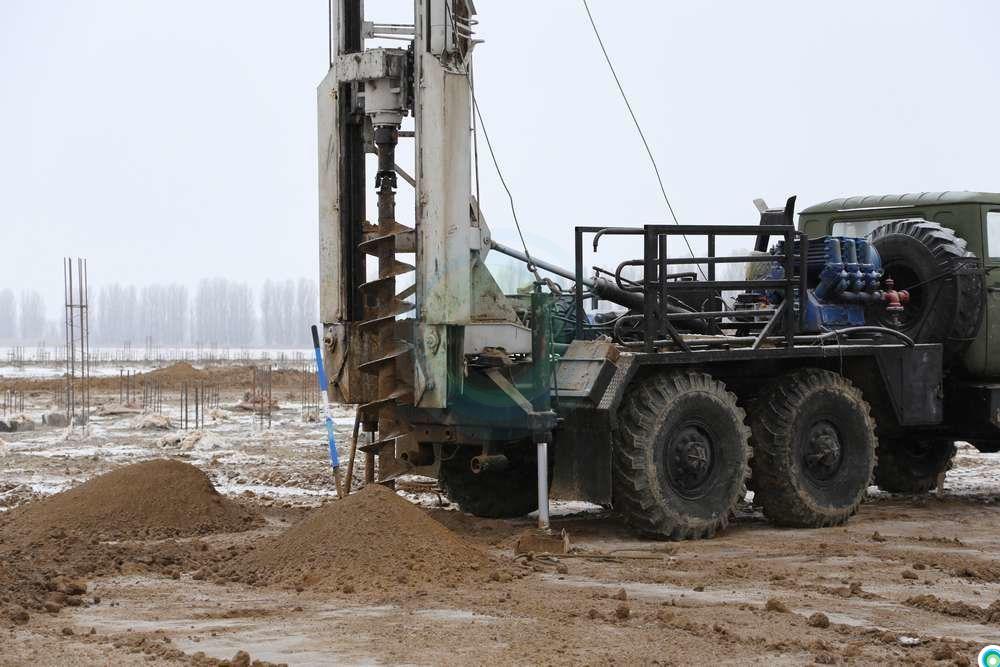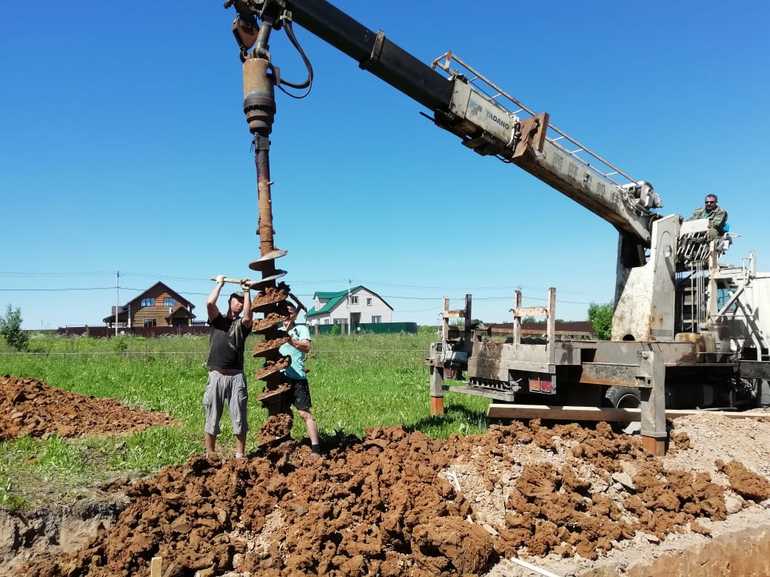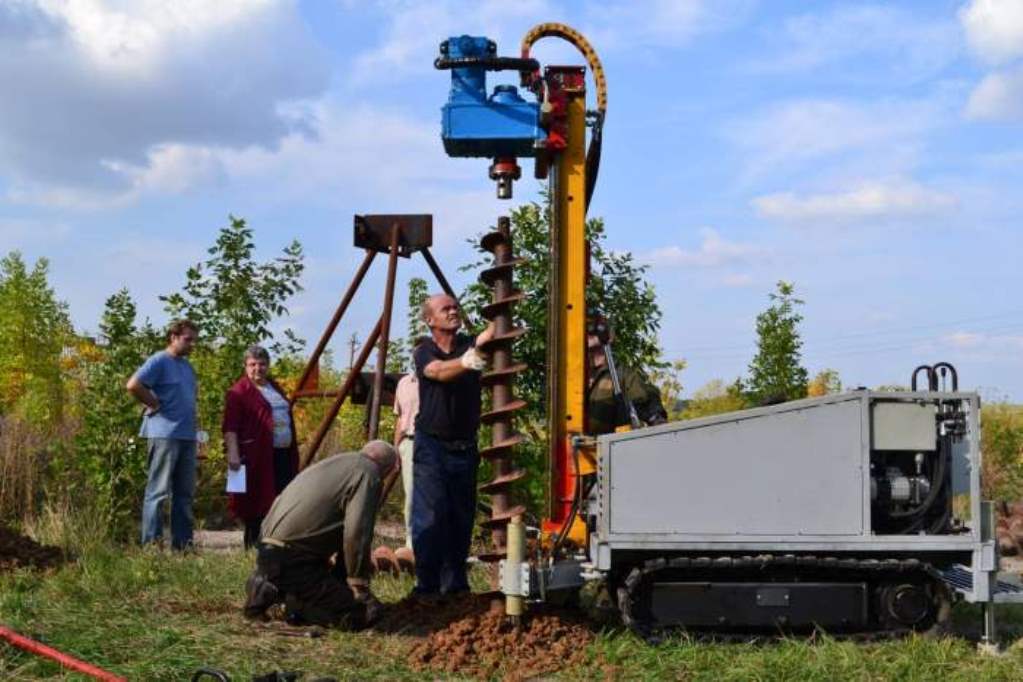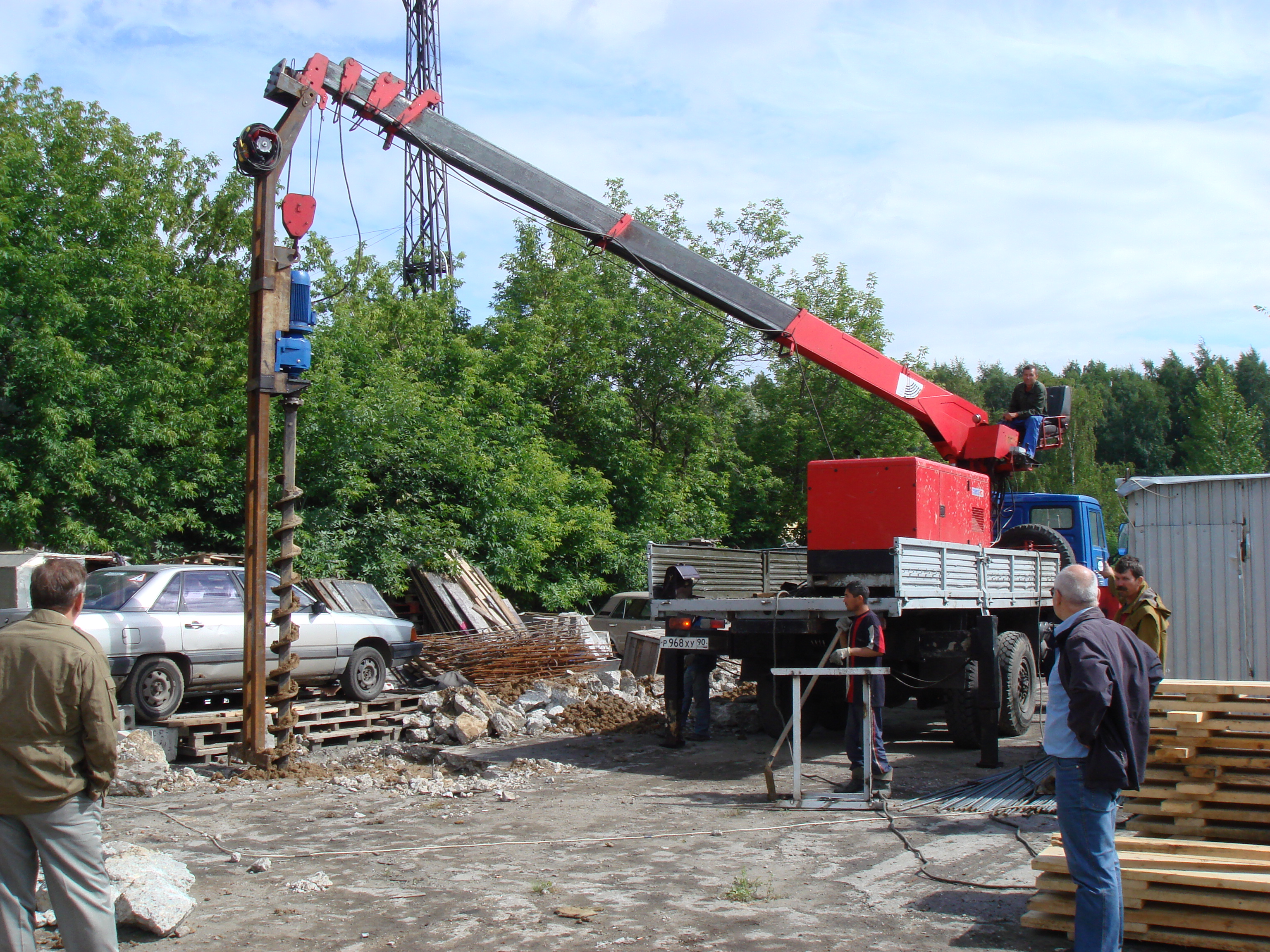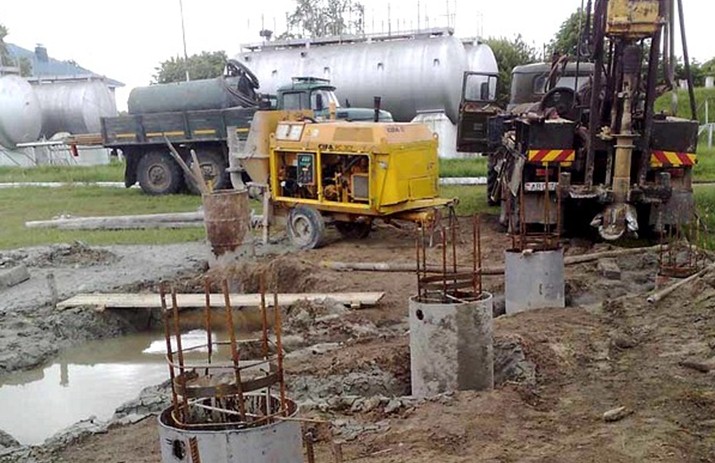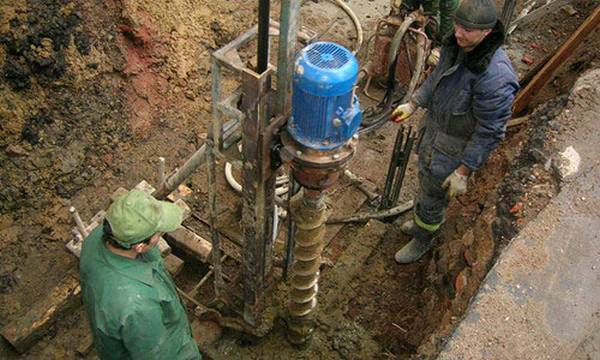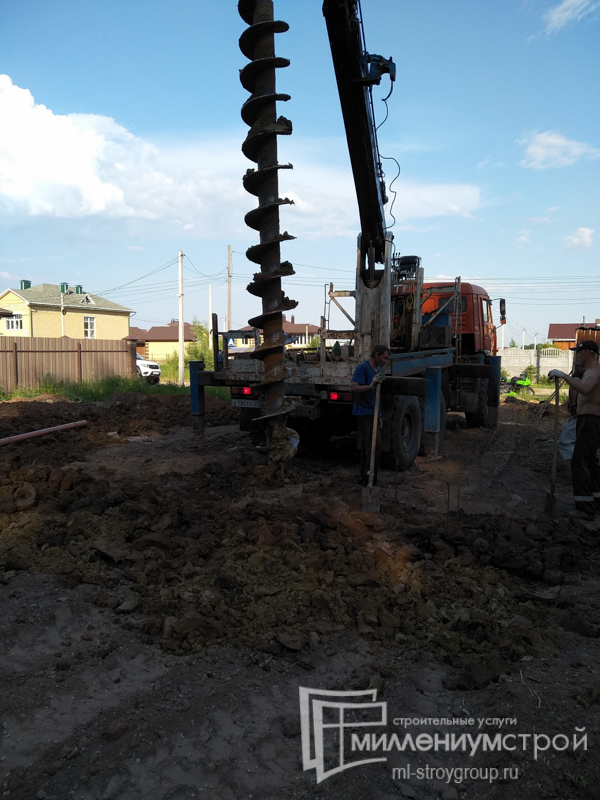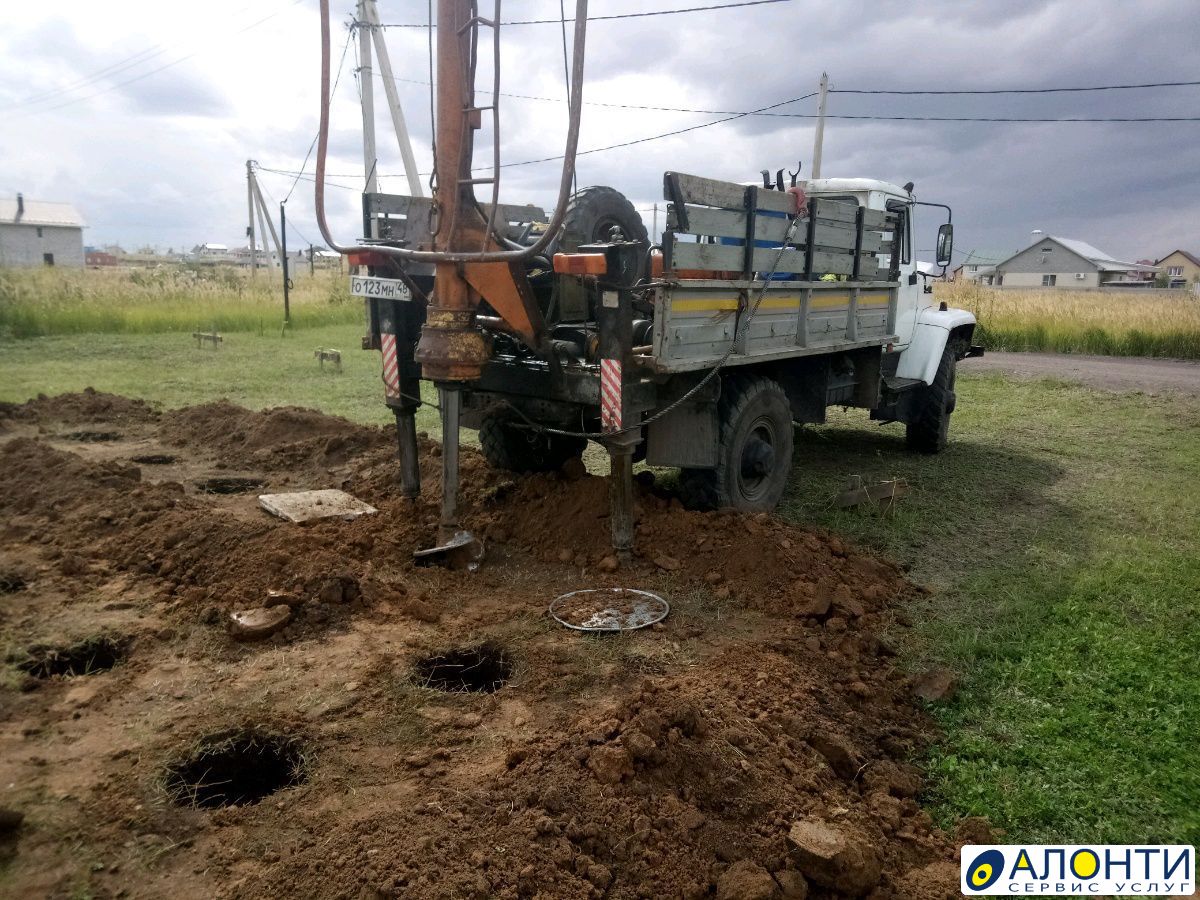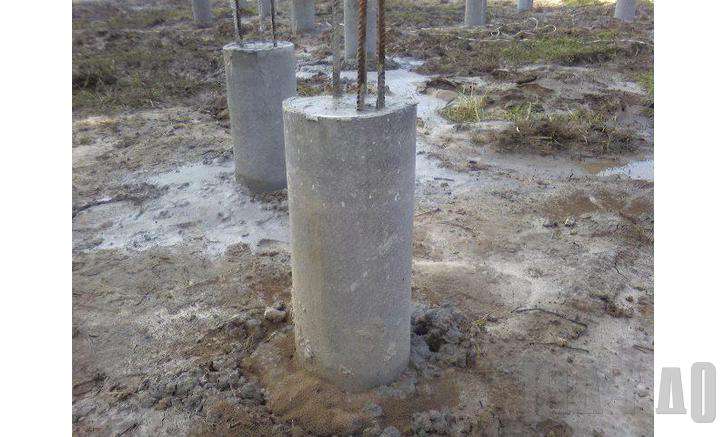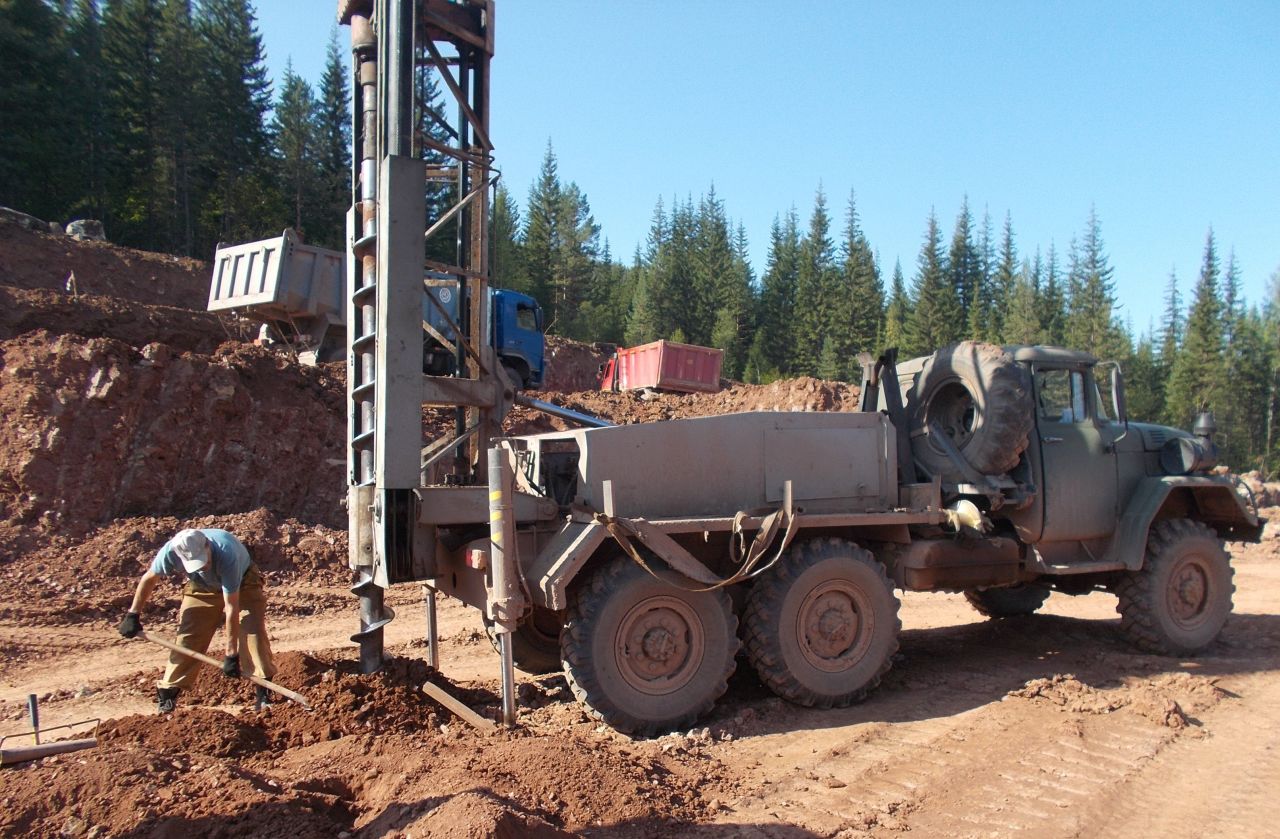Installation of grillage
At the next stage, the piles are drilled and fixed with concrete. To carry out work using the drilling method, tools such as a hand drill or a motor drill are used.
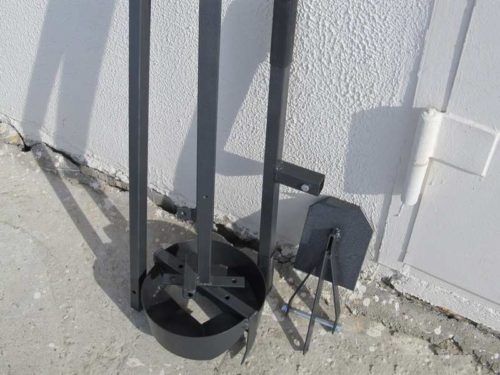 Drill for wells.
Drill for wells.
The sequence of mounting the support structure on piles:
- First, drilling is carried out on the site. The well should be strictly cylindrical in shape with an expansion at the lowest point, which will help to hold on to the pillars more tightly.
- Then the bottom of the drilled holes is filled with concrete.
- Formwork is being prepared. A pipe with a bored hole diameter is made from a piece of roofing material. This pipe protrudes 20-30 cm above the ground level. After that, it is lowered into the well, and the protruding remainder is pulled together by wire.
- A frame is being prepared from reinforcement. To do this, 3 rods are installed vertically, which are then fastened with transverse segments with a step of 50 centimeters. Then the structure is inserted into the hole.
- The well is filled with concrete mortar. The filling should be continuous and compacted every 50 centimeters.
- If there is water in the hole in excess of the permissible rate, it must be pumped out.
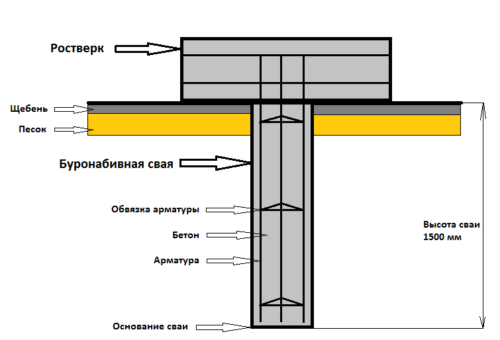
For greater strength and reliability of the pile structure, you need to make the strapping with a grillage. You can make a grillage device with a reinforced concrete tape. The width of the harness is calculated based on the weight that will be supported on it.
To carry out the installation of the grillage, you must perform:
- Installation of formwork on poles.
- A reinforcement structure is installed inside the formwork.
- The reinforcement sticking out of the posts is connected to the frame of the reinforced concrete strapping.
- Then the entire structure is poured with concrete.
- The grillage is made slightly wider than the walls of the house, and at least 30 centimeters in height.
After that, the pouring of the pile foundation can be considered complete.
The video below demonstrates CFA drilling - a continuous full auger:
1 Features of drilling wells (wells) under the foundation
As you know, the construction of the foundation for various types of objects is a very responsible and important stage. The service life of your building will depend on the quality of its construction. In this regard, before starting the process of erecting the foundation, you need to carry out appropriate preparation.
Before drilling wells for the foundation, you need to investigate the soil at the site (it can also affect the borehole caisson). Thanks to this, you can easily determine which type of drill is best used here.
Very often, with individual development, you have to work with heaving and loose soil. Its main feature is mobility, which prevents the installation of certain types of foundations (including tape).
Due to the fact that this unit is light enough and has a sharp tip, the process of drilling a well for water will take place at an acceptable pace, although some effort will still have to be made. In addition, manual hole drilling is an economical option that allows you to drill holes for the foundation.
1.1 Equipment for drilling wells under the foundation
Drilled well under the foundation, ready for concreting
Of course, drilling for foundation piles requires the use of certain equipment. To begin with, you should use an ordinary manual yamobur (also called an earth auger). Thanks to it, at the initial stage, you can create shallow holes (pits).
Then you need to use a special tool
Determining its type, you need to pay attention to the structure under which the base itself is being erected.And if, for example, the design is simple (fence), then you can use the TISE 2 F drill, which is a kind of telescopic system that includes 2 rods
The sections of the rods are different from each other. In this case, work must be carried out with the plow removed (so as not to damage the caisson). The depth of the well (or well) can reach from 1 to 3 meters.
A handle must be used to obtain sufficient expansion at the lowest part. It is activated with one click. In this case, a cylindrical drill element in diameter can reach twenty centimeters. With the help of a removable plow, hemispherical cavities can be produced, reaching a diameter of 40-50 centimeters.
It is thanks to the special cutters that are located at the edges that drilling wells for the foundation of a well (well), even on solid ground, will be quite easy.
In the case when a stony layer of soil (up to 5 centimeters) is encountered during drilling, the main cutters must be picked up and sent to the drive.
If we are talking about the construction of heavier structures, such as brick and stone houses with concrete ceilings, manual hole drilling will be inappropriate. You will need a reinforced TISE 3F drill, the main feature of which is free rotation around the plow head.
This greatly simplifies the process of expanding the piles. The only drawback of this tool is considered to be a significant weight, reaching 10 kg. The diameter of such a drill is 25 centimeters and allows you to easily perform operations of any complexity. The special 70 cm wide handle provides maximum comfort while drilling.
To prepare special holes for the future foundation of the well, you can take a TISE F. drill. The only drawback of this model is that it has been discontinued. But with a strong desire, you can make it yourself, as a result of which you will receive a fairly reliable and very high-quality tool.
Drilling a well with a high-power motorized drill
If you plan to drill a well in winter, you need to purchase a caisson. The caisson will protect it from freezing, since in a concrete or metal insulated room, the temperature is stable above zero.
Based on the foregoing, we note that drilling wells under the foundation is a rather complicated process, the implementation of which can be facilitated by manual yamobr and its other varieties.
Now let's pay attention to the recommended drilling depth. It also matters and is quite serious.
Just like drilling artesian wells, punching wells under the foundation requires certain skills and knowledge.
Technology of the device of bored piles under the protection of inventory pipes
Bored piles protected by inventory pipes are one of the most practical ways to erect the foundation of a building. In order to increase the bearing capacity, they are performed with broadening in the lower part (broadening of the pile heel). After drilling the well, which is carried out under the protection of the inventory pipe, a frame is installed in it, and the well is filled in portions with concrete mixture. After the completion of these works, the inventory pipe is removed from the well in sections. During drilling, the soil is extracted from the surface and loaded onto vehicles for transportation to the landfill.
Installation of piles under the protection of inventory pipes on various types of soil
Due to the fact that these piles can be installed at a great depth with a large diameter, they can be used even on a landslide slope.
In flooded soils, the installation of bored piles under the protection of inventory pipes is temporarily longer than the installation of piles using CFA technology. Well flooding, which is possible due to the presence of groundwater, is delayed by casing pipes.After the concrete is poured, the casing is removed. The use of casing pipes greatly slows down the pace of construction and increases its cost. Sometimes an alternative method is used - instead of casing, the well is filled with a special solution (bentonite or polymers). Due to the pressure, the solution holds the well and it becomes possible to continue pumping concrete. This method also increases the cost of construction and slows down its pace. In addition, the nature-saving factor is still important here: part of the solution inevitably ends up on the surface of the soil, which leads to a deterioration in the ecology of the environment. In soft soils, the construction of a foundation by this method will inevitably lead to their restructuring. As a result of such processes, the volume of drilled soil can be significantly greater than the volume of the trunk. This threatens with uneven subsidence of buildings, the appearance of cracks and deformation of structures. Subsequent soil subsidence may reach below the design level. During the passage of water-saturated soils, it is necessary to create back pressure in the well, filling it with clay solution or water, or create an extended soil plug. The use of an inventory pipe allows to close the horizon of water-saturated soils, to ensure control of the pile parameters and the safety of drilling operations, as well as to guarantee high-quality filling of the pile with concrete.
Benefits of bored piles protected by inventory pipes
The main advantage of bored piles is the possibility of their arrangement to a great depth and large diameter. The use of such piles has proven itself well in cases where the structure will be subjected to heavy loads during operation.
Bored piles are successfully used under the protection of inventory pipes in infill areas, in cramped urban conditions, as well as in cases where construction is taking place near erected buildings. In such cases, during the construction of the foundation, adjacent buildings do not suffer, since there are no dynamic loads. Deformation of soil and crumbling of walls of structures is also excluded. In addition, the maintenance of the construction site is simplified, water consumption is reduced and, of course, costs are reduced.
Other advantages of bored piles under casing protection include:
- unmistakable control of the drilling process, allowing to detect the reaching of the bearing layer;
- the possibility of crushing boulders;
Due to its high reliability, this type of pile is the most popular among bridge builders and transport builders.
Equipment for drilling wells for piles
title = "Drill for a well with your own hands" The simplest and most affordable option is a manual drill, which can be used in summer cottage construction without involving special construction equipment. It can be used to create wells up to seven meters deep. This is not the best way, and far from the most productive, but it can help you complete the work.
If speed is required, or the work “by hand” is not allowed by the peculiarities of the soils, it would be reasonable to use a pit drill (it is enough to simply rent). Pit drills are attached to automobile or tracked chassis, turning them into real drilling rigs. In especially difficult areas, specialized drilling machines can be used.
Complex construction technologies (such as the method of strengthening the soil at the expense of rolled soils) also require additional tunneling equipment (yamobur will not cope). It is already being ordered separately. These can be rotary installations, drilling complexes, etc.
to the menu
Methods
Rotary drilling of wells consists in the fact that initially they pass the leader part equal to the length of the casing section. This method has shown itself very well in a variety of geological conditions, with unequal water saturation of soils.
The use of a typical auger auger (an elongated rod with a tip of increased strength and helical blades) allows the crushed soil to be lifted up as quickly as possible. The rate of passage of holes can reach 120 cm per minute. The drilling complex periodically pulls out and raises the working part, freeing it from the adhered soil.


High-quality adherence to technological principles will allow for a working cycle, from one lifting of the drill to another, to form holes up to 10 m in length. Another option for penetration involves covering the walls of the hole with an inventory pipe formed by single steel sections. Each piece can be up to 6 m in length. At the bottom is a carbide-tipped cutting part. When the drill moves down, the pile is pressed at the same time, it blocks the seepage of water from the soil and prevents the walls from collapsing.
Having reached the zero level, determined by the foundation project and SNiP for a specific area, the auger drill is lifted up. Water seeping from the soil into the prepared cavity is removed. But a reinforcing frame is immersed there. The final step is to saturate the empty space with concrete.


Another type of drilling is the use of a core auger, which feeds the solution through the cavity in the core itself. This approach ensures the formation of 400 linear meters. m of channels for a standard 8 hours. In this case, the channels can be large in diameter (from 50 cm) and reach 30 m in depth each. This is due to the systematic increase in the length of the auger until it reaches a predetermined mark. The saturation of the cavity with the solution is combined in time with the lifting of the mast, this helps to make an array for rammed piles. Remember that concrete is injected under pressure and therefore becomes stronger than usual.
If the introduction of a reinforcing frame is envisaged, it is simply pressed mechanically into small wells, and it is introduced into large wells using a vibrating submersible machine. A typical auger works well in dry or nearly dry soil. There is no need to prepare and strengthen the internal cavities of the wells.
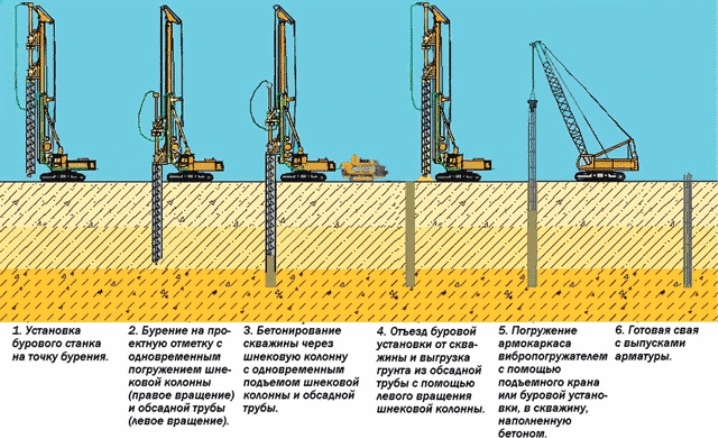
The inventory tube approach also has its merits. Only it can form channels with a diameter of 1500 mm in very wet soil and quicksand. Wet drilling helps to strengthen the borehole through medium-gravity clay or sand.
It is the wet technique that is considered the least noisy, and it also does not destroy the layers of the soil as a whole. In some places, the channel can be widened up to 350 cm, which guarantees the highest stability of the base.
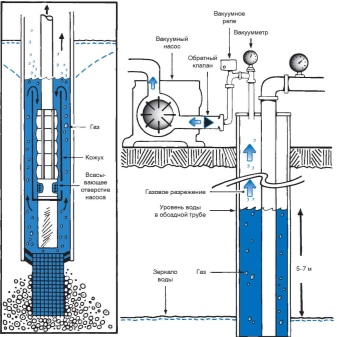
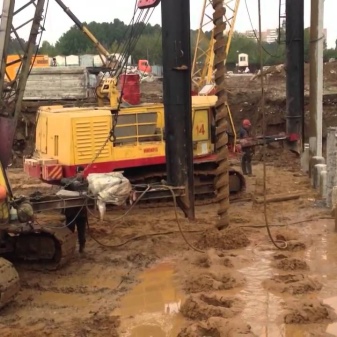
The lack of "leaders" is the obligatory preparation for drilling. It is also worth considering that the well will be 30-50 mm smaller than the reinforced concrete structure, the depth reduction will be approximately 1 m.
Leader drilling is recommended if:
- A layer of sand of increased density was found.
- The top layer of the soil is hard.
- The site is located on permafrost.
- The construction site is abundantly filled with rocky soil.
- The piles are to be driven to a great depth.
- The territory is filled with dispersed soil with a very low density.
Test drilling for pile placement allows us to once again weigh all the subtleties and nuances. In some cases, an error can be very expensive, and it is revealed after the completion of all construction work in general. The properties of the soil vary widely in space, and if it is completely solid at 10 - 15 m, this does not mean that there will be no unexpected phenomena in a particular place. They also turn out to be voids, aquifers, loose particles and the departure of a really strong layer to an unusually great depth. Quite often there is such a problem as fluctuations in freezing lines.
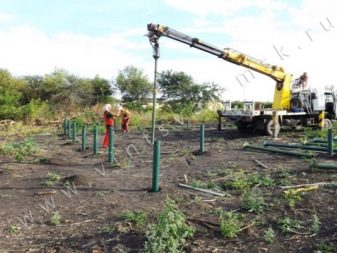

Installation of piles with casing pipes
The technology of drilling holes for reinforced concrete or concrete supports under piles using casing pipes provides for the production of work in absolutely any conditions, in any soil and in territories of any complexity. The cycle of penetration in meters is equal to the size along the length of the casing. The drill passes this length, excavation is carried out, then a pipe is installed in the well, and again the "drill-pipe" cycle, and so on until the target depth is reached.
In soft soil, the well is formed by pressing the casing. For this, hydraulic jacks with a translational-rotational mechanism are used. At the same time, soil is removed from the trunk and removed from the construction site. The casing pipe protects the well from "quicksand", prevents it from siltation. Such piles reliably withstand both vertical and horizontal loads. If it is provided for by the projects, then the bored piles are reliably tied into simple and complex pile structures, the so-called “pile field” is installed.
Watch a video of how do-it-yourself pits are made for piles.
Only specialists can drill quality well. Difficulties in drilling arise when there are large layers of groundwater at a depth. In this case, it is required to carry out measures for the organization of drainage and the device of the corresponding hydraulic structures.
Pile construction has practically no flaws in technical terms, except for one thing - it is difficult to carry out the pile foundation on your own. By the way, the arrangement of such a foundation significantly reduces the estimated cost and construction time.
Why do you need trial drilling
The initial stage of work is trial drilling for piles. Its purpose is to determine the screwing depth and the length of the supports. In the process of a test puncture, the type of soil, its composition, and the level of groundwater are determined. The immersion of test piles is necessary during construction on the sites:
- With imported soil. Bulk soils with the inclusion of gravel, construction waste, woodworking industry waste.
- With weak soils, which do not allow to reliably fix the supports at a shallow depth. These are areas with quicksand, sandy or boggy soils, peat bogs.
- With rocky spots, coarse-grained soils, where the installation of screw piles is technically impossible.
Obtaining detailed information allows you to select piles with the required characteristics, to provide the necessary bearing capacity of the foundation. In our company, you can order a soil survey in St. Petersburg and the Leningrad region.
Types of drill supports
The foundation on piles differs significantly from other types of foundations: linear, monolithic and other massive foundations.

If such structures are capable of transferring the load along the perimeter of the building or over the entire area (in the case of monoliths), then the piles transfer the load directly at the point of support and on the lateral surfaces of the wells.
Depending on which part carries the main load, two types of supports are distinguished:
- Stand pile. Such a structure rests on a solid layer of soil, the load is transferred to the soil at the place of support.
- Hanging pile. This species withstands the stress due to the surrounding soil.
Most of the bases are made of hanging bored piles, since the solid layer of soil is located at a great depth.
According to the manufacturing technology, supports are of two types:
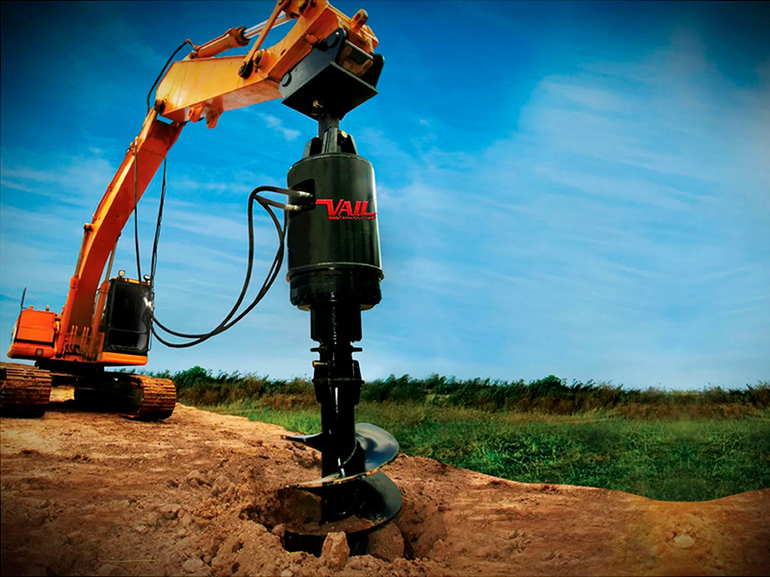
- Bored. A frame made of reinforcement is installed in the drilled well and concrete is poured in layers of 30 cm using a hose with an air release and a seal.
- Buroinjection. It differs from the first type in the way of concreting. The solution is filled by means of a hollow screw under pressure.
The technology of drilling wells for the foundation with the use of casing deserves attention. This method of making piles is used in small areas and on floating ground.The casing restrains the pressure of the ground, preventing it from moving and crumbling.
As the well deepens, the pipe is installed in sections welded together or fastened with special clamps. At the end of the process, it is dismantled or remains in place, filled with concrete mortar and, after hardening, becomes a monolithic support.
Casing pipes are made of the following materials:
- alloy steel;
- plastic;
- polypropylene;
- asbestos cement.
Bored piles
The name "bored piles" speaks for itself. If this concept is denoted in simple language, then we can say that the drilled hole is stuffed with filler. As such, reinforcing steel for the frame, metal pipe for well casing and concrete are used.
Thus, deep in the ground, a strong rod, called a pile, is created, capable of taking heavy loads from both the ground and future buildings and structures. A series of such piles, tied into a single structure, creates a solid foundation.
Preparation for the installation of bored piles
Cast-in bored supports
Industrial construction technologies are now smoothly flowing into housing and civil. One of them is the application bored piles for erection of new buildings in places of existing buildings or on a complex landscape.
They are also successfully used to strengthen the foundations of existing buildings and structures. Depending on the conditions and quality of the soil, preparation for the installation of piles is divided into:
- drilling in dense soils;
- drilling in soils with weakened and non-uniform density;
- drilling wells in weak soils using casing pipes.
Arrangement of piles in casing tubes allows for the possibility of linking them into pile clusters and complex foundation structures
It is important that the device of bored piles with the use of casing pipes in some cases is carried out in soils of any quality
Installation of bored piles in dense soils
In this case drilling of dense soil under the piles is carried out by a drilling rig operating by a rotating method. For this, special devices are used - augers, bailers, drilling cylinders.
Pitch under the pile
The soil from the well is removed from the site, and the upper part of the shaft is equipped with a special pipe to prevent excess soil and debris from entering the well.
If the well requires drilling, then this work is performed using a special reamer, which is attached to the installation instead of the drill. After the end of the drilling process, the bottom of the well is compacted with crushed stone or dense concrete.
Next, the process of creating the pile itself takes place in strict accordance with the project: the installation of the reinforcing cage (if necessary) and concreting. The concrete mixture is poured using dynamic formwork, which is used as concrete pipes.
The preparation of the concrete mixture is carried out in mobile concrete mixers or its delivery by concrete trucks from the territory of the manufacturer is organized. To improve the density and strength of concrete, it is compacted with deep vibrators. Vibrators mounted on a receiving hopper in a well mouth are often used. The pile head is formed using a special reusable inventory formwork. In the process of reinforcing the head, the necessary embedded parts and connecting elements are installed.
Installation of bored piles in heterogeneous soils
Pit drilling process
Bored piles in unstable, heterogeneous and weakened soils are mounted using a special technology. As in the previous case, wells are drilled using a rotation method. If necessary (for the passage of a drill through rocky areas), percussion devices are used.
And in order to protect the walls of the well from collapse, its cavity is filled with water under pressure or a solution of clay.Working with clay mixtures creates difficulties when using it in the winter, and also complicates the operational control over the quality of the work performed.
Further, the drilled well must be filled in strict accordance with the project. The methods of reinforcement, concreting, and compaction of the concrete mix practically do not differ from those described above. These works are carried out after cleaning the bottom of water, clay, as well as sealing the bottom of the well.
The concrete mix is made according to laboratory selection with the use of plasticizing additives for its better workability. Antifreeze additives are used at subzero temperatures.
We recommend watching a video showing the complete process of installing bored piles.
Piling in wells
This type of laying occurs by driving the pile into a drilled hole, the depth of which is made using a drilling machine. The concrete solution is poured into the well until it dries completely, and then the pipe is removed, which served as the form of the grillage. Such piles can be made with an extension.
The borehole depth serves as the site for the creation of the pile, which can be created using various methods. It depends, first of all, on the engineering and geological features of the conditions of the bored elements. To lay piles using this method, rotary, percussion-rope and grab auger method are used.
Rotary drill machines operate on a cyclical and periodic basis. In the course of the process, the depth of the pit is created by portionwise removing the earth from the soil layer. The drill speed is from 0.4 to 1.3 m / min.
To form the head of the pile, it is necessary to use a casing nozzle. It is also used for fastening fittings to equipment. This technique helps to create grillages with the following indicators: diameter - from 40 to 100 cm, depth up to 30 meters.
In order to increase the bearing characteristic, the broadening process can be performed. To do this, you will need to perform actions in several stages. The depth of the well should have indicators from 16 to 25 meters and its diameter should be 60 - 80 cm. All working moments for creating the foundation are made according to the technical scheme. Shallow foundations are mainly built on a pile mechanism for buildings that do not have basements.
This means that the drilling process is a necessary and very important component of pile installation. It is worth remembering that it is the pile foundation that may be mounted in such conditions in which the tape type will be a pointless waste of time.
Hand drilling
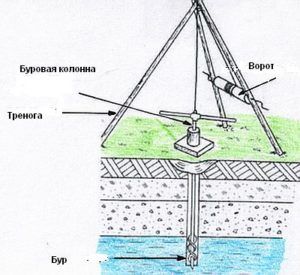 The classic scheme of hand drilling a well
The classic scheme of hand drilling a well
Drilling a well for a foundation pile manually is a physically difficult and time-consuming process that makes sense only for small volumes and shallow hole depths. It is used on clayey, heaving soils. The resistance of dense soil is difficult to overcome, it is difficult to maintain vertical drilling of the hole. Two people work with hand tools, the efforts of one person are ineffective.
Boers TISE were widely used in private housing construction. The abbreviation TISE stands for “Technology of individual construction and ecology”. The drill is distinguished by a structural solution that makes it possible to obtain underground expansion. The expansion increases the support area and the bearing capacity of the pile. When drilling under the foundation, the earth is cut with edges and rises to the surface.
Power tools reduce labor costs. The main thing in the process is to keep the drill in a strictly vertical position. For the production of work, 2 people are required. Motor-drills run on gasoline, a mixture of gasoline and oil. Electric earth drills operate from the network, have insufficient power, the engine overheats from the load, therefore they are not used in the construction of the foundation.
Prices for drilling leader wells
The construction company "Bogatyr" offers its customers one of the lowest prices for leader drilling in Moscow and the region.
We calculate the cost of creating a leader well based on its depth - the base price of one running meter of drilling is 300 rubles (it may vary depending on the type of soil and the amount of work).
It is also necessary to take into account the price for the relocation of construction equipment - in Moscow and the region it is 20 thousand rubles (relocation to neighboring regions is possible, its cost can be clarified by contacting the representatives of the company).
Leader drilling allows piles to be vertically mounted on a site with a dense soil composition. This method is most relevant in winter, since it facilitates the process of driving in the sheet pile during the construction of the foundation.
Leader drilling makes it possible to reduce the resistance of the earth's surface, as well as to set the entire structure to a considerable depth. In addition, vibration and noise levels are reduced during installation.

